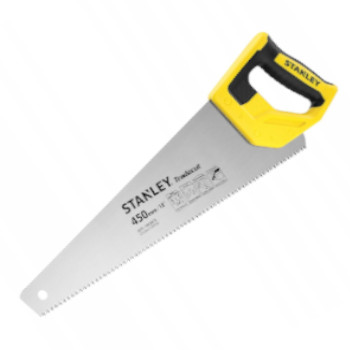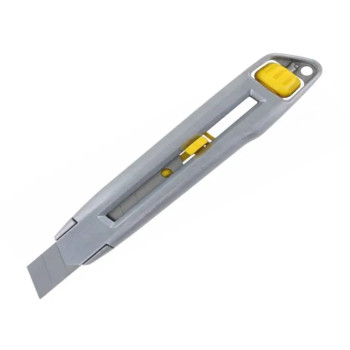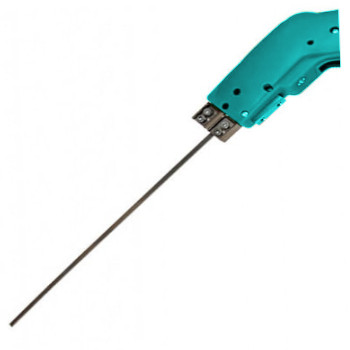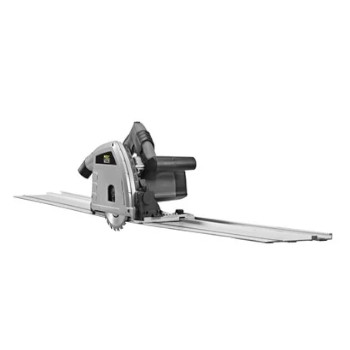
CUTTING TRICKS FOR KINGSPAN AND CELOTEX PIR INSULATION BOARD WITHOUT DUST*
Both Kingspan and Celotex offer PIR boards, which are essentially derived from polyurethane, a plastic material. Plastic has electrostatic properties, which means that cutting it results in particles of the material sticking to the body, making it challenging to clean. When attempting to shake off the particles from your hands, they often transfer to another part of the hand, sticking in a different place. In this article, we will describe the best methods for cutting Kingspan and Celotex insulation boards without creating dust. We will present the top tools for the job and discuss their advantages and limitations. Stay tuned to learn the techniques that will help you achieve precise and clean cuts while minimising dust particles.
DUST-FREE CUTTING TECHNIQUES: 2 METHODS FOR KINGSPAN AND CELOTEX INSULATION BOARDS
CUTTING PIR INSULATION WITHOUT DUST - STANLEY KNIFE
 The best method for cutting PIR insulation boards from Celotex and Kingspan is to use a Stanley knife.
The best method for cutting PIR insulation boards from Celotex and Kingspan is to use a Stanley knife.
This technique involves making multiple cuts in the same place with increasing pressure on the knife. This method has limitations in terms of the thickness of the board and is practical only for thicknesses ranging from 15mm to 50mm.
However, it is the cleanest and fastest way to cut PIR boards, as it does not create dust, prevent particles from sticking to the hands, and does not require any specialised knowledge.
CUTTING PIR INSULATION WITHOUT DUST - WATER
 Another method that can be used is the application of water. This method is rarely used due to its additional requirements. As we generally know, the use of water creates additional mess in the workspace. Firstly, you need to have water available, and secondly, you will need to clean up the dirty water afterwards. However, when you use water to cut PIR insulation boards, you will reduce the electrostatic charge of the particles, thereby minimising their airborne movement and sticking to the body.
Another method that can be used is the application of water. This method is rarely used due to its additional requirements. As we generally know, the use of water creates additional mess in the workspace. Firstly, you need to have water available, and secondly, you will need to clean up the dirty water afterwards. However, when you use water to cut PIR insulation boards, you will reduce the electrostatic charge of the particles, thereby minimising their airborne movement and sticking to the body.
To cut a PIR insulation board without dust, you need to spray the cutting surface with water. It is best to use a spray bottle that previously contained window cleaning fluid. This process is time-consuming, but it reduces dust formation by approximately 60%.
CELOTEX & KINGSPAN CUTTING TOOLS
Here are some tools that can be used to cut PIR insulation boards. These are the most commonly chosen tools by installers:
HANDSAW
 The handsaw is the most commonly chosen tool for manual cutting of PIR boards such as Celotex or Kingspan and is preferred for its cutting speed. Please note, the larger the saw teeth used for cutting, the more debris it may generate. Handsaw leaves a considerable amount of debris that needs to be cleaned up afterward.
The handsaw is the most commonly chosen tool for manual cutting of PIR boards such as Celotex or Kingspan and is preferred for its cutting speed. Please note, the larger the saw teeth used for cutting, the more debris it may generate. Handsaw leaves a considerable amount of debris that needs to be cleaned up afterward.
This method becomes challenging to use for thicknesses above 140mm. Moreover, the hand saw tends to bend in the material and may result in angled cuts. Therefore, it is recommended to use a timber guide as a cutting guide. A timber guide helps to ensure straight and accurate cuts by providing a straight edge to guide the handsaw.
STANLEY KNIFE
 The Stanley knife is the best tool for clean manual cutting of Celotex and Kingspan PIR boards.
The Stanley knife is the best tool for clean manual cutting of Celotex and Kingspan PIR boards.
It has limitations regarding board thickness, typically being able to cut up to a maximum thickness of 50mm.
This method does not leave any debris, is dust-free, and relatively fast.
After prolonged use, it may cause hand fatigue due to the pressure required to cut through the PIR board.
HOT KNIFE
 Some claim that a hot wire tool can be used to cut PIR boards, but this is incorrect. Products made from PIR and PUR materials are not suitable for hot wire cutting, as attempting to do so would release unpleasant fumes.
Some claim that a hot wire tool can be used to cut PIR boards, but this is incorrect. Products made from PIR and PUR materials are not suitable for hot wire cutting, as attempting to do so would release unpleasant fumes.
Moreover, the hot wire won't cut through the foil present on both sides of the board.
The foil is resistant to thermal cutting. Even if you manage to cut a PIR board using a hot wire cutter, it won't last long and will likely only serve for a few cuts. Therefore, the hot knife tool is only used for cutting regular styrofoam, which is not covered in aluminium foil.
CIRCULAR SAW
 The most precise method of cutting Celotex and Kingspan PIR boards is mechanical cutting using a circular saw. This method leaves straight edges; however, it requires a dust extraction system and a power supply. It is the fastest method when dealing with a large number of cuts. Its use is limited to a certain range of board thickness (based on the blade's depth) and typically goes up to a maximum of 100mm, depending on the circular saw brand.
The most precise method of cutting Celotex and Kingspan PIR boards is mechanical cutting using a circular saw. This method leaves straight edges; however, it requires a dust extraction system and a power supply. It is the fastest method when dealing with a large number of cuts. Its use is limited to a certain range of board thickness (based on the blade's depth) and typically goes up to a maximum of 100mm, depending on the circular saw brand.
HEALTH & SAFETY WHEN CUTTING PIR
When cutting PIR insulation boards like Celotex or Kingspan, it is crucial to prioritise health and safety. Here are some important precautions to take:
Personal Protective Equipment (PPE)
Always wear appropriate PPE, including overalls, a hat, a mask, and goggles. This helps protect you from inhaling dust particles and prevents them from getting into your eyes or onto your skin.
Dust Management
PIR dust can be harmful to your respiratory system, so it's essential to implement effective dust management measures. Consider using a dust extraction system or a vacuum with a HEPA filter to minimise airborne dust. This will help maintain a cleaner and healthier work environment.
Cutting Techniques
Determine early on whether you need a tight fit or a foam fit for your installation. This decision will affect the cutting method and dimensions. Take the time to measure and mark the boards accurately before cutting to ensure precise fits and minimise wastage.
Secure Work Area
Properly secure the work area to prevent accidents and injuries. Make sure the boards are firmly supported, and use clamps or a timber guide to ensure stability and straight cuts. Keep the work area clean and organised to avoid tripping hazards.
Ventilation
If possible, work in a well-ventilated area to help dissipate any fumes or odours that may be present during the cutting process. Open windows or use fans to improve airflow, if necessary.
Clean-Up
After cutting the PIR boards, clean up the work area thoroughly. Dispose of any waste materials properly, and vacuum or sweep the area to remove any remaining dust or debris. This will help maintain a clean and safe working environment.
Remember, maintaining a focus on health and safety practices while cutting PIR insulation boards is crucial for the well-being of both yourself and others working in the area.
CONCLUSION
In conclusion, cutting Celotex and Kingspan insulation boards requires careful consideration of techniques, tools, and safety measures. Whether you choose to use a saw, Stanley knife, or other cutting tools, it's important to prioritise safety by wearing appropriate protective gear. Additionally, using a timber guide or straight edge can help you achieve clean and accurate cuts.
Bibliography
1. youtube.com “How to cut thin insulation board mess free! Cutting PIR board for beginners. DIY top tip!!”, June 9, 2020, accesed April 09, 2021
https://www.youtube.com/watch?v=5pTfQVzZtkA
Related articles:
HOW TO CUT A PIR INSULATION BOARD?
PLASTERBOARD CUTTING TECHNIQUES
*All the information provided in the content published on Insulationgo blog is for informational and educational purposes only. Insulationgo LTD makes every effort to ensure the accuracy and timeliness of the content, but we do not assume any responsibility for any errors or omissions.
The information presented on this blog should not be considered as professional advice or a substitute for consulting relevant experts. Before making any purchase decisions or taking action based on the information presented here, it is strongly recommended to contact the product manufacturer directly to verify the details and ensure its suitability for your specific needs.
By using this blog, you acknowledge and agree that Insulationgo LTD shall not be held liable for any damages, losses, or inconveniences arising from the use or reliance on the information provided herein. This limitation of liability applies to all users of the blog, including but not limited to visitors, readers, and subscribers.










































































































